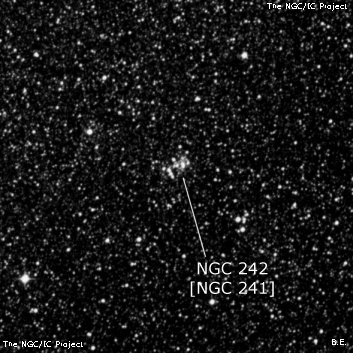
John Herschel discovered NGC 242 = h2343 on 11 Apr 1834 and recorded "pL; vF; R; vgbM; (in a sweep below the pole and ill seen) the RA is probably also in error. On a second sweep he recorded "a binuclear nebula, or two, vS, R, running together." Finally on a third sweep he noted "a small irresolvable knot in the bright part of the Nubecula Minor." NGC 241 = h2343, recorded in Aug 1834, is a duplicate observation (see notes).
Interestingly, Pietro Baracchi observed the cluster on 16 Dec 1887 (as well as numerous other SMC clusters) with the 48" Melbourne telescope and logged it as two objects (labeled as "D" and "E") "almost forming a double nebula". The main NW clump was called "pB, very small, nebulous star" and the SE knot as "pB; eeS; nebulous star very close to D. I believe two minute stars in D and one in E which makes the objects sparke, many stars in the field." This matches Herschel's description of "a binuclear nebula, or two..." SIMBAD labels the NW clump as NGC 241 = Kron 22w = Lindsay 29w and the SE clump as NGC 242 = Kron 22E = Lindsay 29e and NGC 241/242 is listed as a star cluster pair in 2000A&AS..146...57D.
400/500mm - 18" (7/10/05 - Magellan Observatory, Australia): at 282x, this SMC cluster appeared fairly bright, slightly elongated E-W, 0.8'x0.6'. A faint star is at the west end and another faint star or clump of stars is at the SE end. A pair of mag 12.5/13 stars lies 2.5' SW. NGC 248 lies 9' NE and NGC 256 can be found 11' ESE.
Notes by Steve Gottlieb